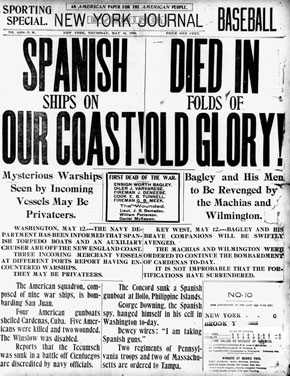Yellow journalism, also known as yellow press, is a type of journalism whose sole purpose is to use eye-catching headlines in order to sell more newspapers. Stories offer news that is hardly, if at all, researched. Techniques of Yellow journalism include exaggerating news stories and sensationalism.
The term yellow journalism was named after the “Yellow Kid”, a character from the comic strip Hogan’s Alley, printed in the New York Journal.

A sketch of the Yellow Kid. New York Journal, 1800s.
The man credited with the creation of the term “yellow journalism” is William Randolph Hearst. In 1887, he acquired the New York Journal and began circulation with Joseph Pulitzer’s New York World. Once he combined work on these two papers, yellow journalism began to emerge.
Below are two examples of yellow journalism in the New York Journal, created by Hearst. Hearst exaggerated stories about big events that were taking place and made them out to be more than they were.

Example of yellow journalism by William Randolph Hearst, New York Journal, 15 Feb 1898
The image below is an exaggerated report about the Spanish-American War. The report was highly imaginative and claimed that Spanish ships were nearing the American Coast. New York Evening Journal, sister publication of the morning New York Journal. May 1898.

Example of yellow journalism. New York Evening Journal, sister publication of the morning New York Journal, May 1898.
The term “yellow journalism” is now used to describe news that is presented in an unethical or unprofessional way.

Leave a response